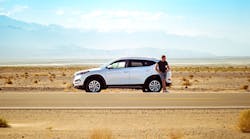As a historic heatwave hits the West Coast, it is straining the electric grid. And, for proponents of electric vehicles, it’s creates a bit of a conundrum.
How so? As the heatwave continues to build, the California ISO has asked residents to relieve pressure on the electric grid, in part by charging EVs at off peak times. This comes at a time when an aggressive move to build a robust EV industry is well underway, including the 2035 target date to end sale of gas vehicles in California, events straining the utility grid could lead to limited mobility and high costs to charge. While this instance will be short lived, other events will transpire in the future, putting similar strains on the critical infrastructure.
As with any initiative, hiccups are sure to surface, which often prompt innovative solutions – a defining characteristic for the U.S. manufacturing community. Of course, if these issues are not handled carefully, the result could be a huge catastrophe.
Below, Paul DeCotis, senior partner in West Monroe’s energy and utility practice, shares his insights with IndustryWeek.IW: What steps does the energy and utility (E&U) industry need to take to head this type of situation off, especially as the focus on EV intensifies?
DeCotis: The E&U industry has few options for accommodating severe weather events that challenge wholesale electricity market operations.
Regional transmission organizations and independent system operators throughout the country manage wholesale transactions and network reliability. The utilities manage only their own local distribution grid which provides electric service directly to customers. They have the responsibility to communicate to their customers if there is a need to reduce demand or shift load to maintain the integrity of the network on behalf of wholesale market operators. It is the responsibility of the local utility to invest in their own grid to maintain reliability and they can manage their local distribution grid to adapt to changes in electricity supplies available in the market. As most utilities do not own generation, they buy electricity from the market just like other electricity providers. It is difficult, if not impossible, for utilities to procure supplies when such supplies are not available in the market.
Others in the energy sector like power plant owners and operators, electric storage, and renewable energy providers, however, can plan to have more capacity available in anticipation of severe weather to backstop supplies when the market tightens. This comes with some cost to developers that choose to carry excess supply inventories, which are used only as needed. And, ultimately, such costs are borne by consumers.
Consumers demand certainty regarding mobility and if problems persist like limiting when and how much charge an EV receives at any given point in time, it will likely slow the pace of adoption. Consumers want to travel when they want or need to unencumbered by when fuel might be available.
IW: What role can/should consumers play in resolving the issue?
DeCotis: Consumers can invest in distributed energy resources, including solar, geothermal energy, energy storage and demand response among other alternatives to have electricity available when supplies tighten in wholesale markets. They can also postpone charging vehicles at the time of supply shortages, which could then impact their mobility as their travel is constrained by lack of fuel availability.
But as with most things, there are certain tradeoffs that come into play. If they must charge their vehicles at the time of peak demand when supplies are tight but available, they will pay a higher price – often significantly higher. And, if supplies are not available, they cannot charge at all unless they have their own electricity supplies via renewables energy resources or storage.
There is a role here to be played by the private sector and government to support resolving supply issues. Utility regulators can also be more lenient by allowing distribution utilities to own generation as backup for use when market supplies are constrained or unavailable.
IW: What impact do you anticipate such events having on the EV trend?
DeCotis: Electricity supply availability and the high cost of charging vehicles at the time of system peak can impact the purchase of electric vehicles. If fuel supplies, in this case electricity, are scarce or easily disrupted or if there is price uncertainty and consumers are dependent on their vehicle for mobility to jobs, shopping or health care, they will be less inclined to purchase an EV. Likewise, people living along emergency evacuation routes will be less likely to purchase an EV unless EV charging stations are located strategically along the evacuation route and there is certainty that supplies would be available when needed.
While EVs are an important strategic component to decarbonization strategies in transportation, other components like hydrogen for long haul trucking, cargo ships, air travel and natural gas-powered vehicles can create competition in the industry and still reduce carbon emissions.





